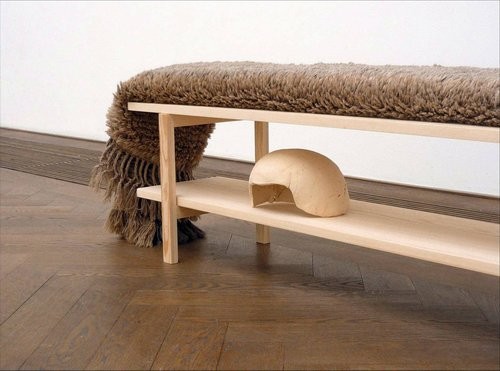Mental Archaeology
22 Sep - 19 Dec 2010

© Thea Djordjadze
Untitled, 2009
Wood, plaster, foam, carpet, papier-måché, paint
Installation: 26,3 x 148 x 11,8 cm
Photo : © Thea Djordjadze / Kunsthalle Basel
Courtesy Sprüth Magers Berlin/London
Untitled, 2009
Wood, plaster, foam, carpet, papier-måché, paint
Installation: 26,3 x 148 x 11,8 cm
Photo : © Thea Djordjadze / Kunsthalle Basel
Courtesy Sprüth Magers Berlin/London
MENTAL ARCHAEOLOGY
Matti Braun, Thea Djordjadze & Jean-Luc Moulène
22 September to 19 December 2010
Opening, Tuesday 21 September 2010, from 5 P.M. to 9 P.M.
A joint exhibition in partnership with Kunstverein Nürnberg – Albrecht Dürer Gesellschaft
Curators: Kathleen Rahn & Claire Le Restif
Mental Archaeology is the title that Kathleen Rahn and Claire Le Restif (directors respectively of Kunstverein Nürnberg – Albrecht Dürer Gesellschaft, and the Centre d’art contemporain d’Ivry – le Crédac) have given to a show featuring three artists whose work is especially close to their hearts.First, there is the Georgian artist Thea Djordjadze (born in 1971), whose sculptures, generally done in small formats and in extremely fragile materials, express the instability of matter (clay, plaster, papier mâché...). For each new exhibition, Djordjadze likes to develop new dialogs between her pieces. The artist also infuses her works with memory and forgetting without summoning these notions explicitly. Collection of objects, fetishes, reinvented “ethnographic” displays, Djordjadze’s works reveal their own archaeology, partially constructed or, paradoxically, partially destroyed. There is one piece, for example, that she created to be burnt and the ashes then buried.If archaeology is inverted in Djordjadze’s art, it is reinvented in the work of Matti Braun (born in 1968) with the installation Ozürfa (a part of which was shown in the 2009 show “Le Travail de rivière” at Crédac). The title of the piece here translates as “the real Urfa”. The mythic city of Urfa, in Turkey, is considered the site of the Biblical Garden of Eden. Like an explorer sharing the rediscovery of a site, Braun has in fact invented various relics of an authentic Urfa. He brings together and fuses disparate stories, conjuring up, for instance, the miracle of Abraham through the skeletons of three carp placed in a copper display case, elements that exist side by side with a copy of the film “Yol” by Yilmaz Güney (1937-1984), the 1982 Palme d’or at Cannes.
Jean-Luc Moulène (born in 1955) is exhibiting a number of different elements from his work. Two sculptures, four monochromes done with Bic felt-tip pens (black, red, and blue and green), four drawings “in motion” done in black lead pencil, and a range of photographs, including a series of seven of a stone that makes a complete circuit around the subject.
“Archaeology” in this show isn’t taken literally then, as the science of ancient objects. It is understood more as a movement of the mind that invites artists to “dig up” undiscovered elements or force the events of the matter of the mind to leave a trace on the surface of things.What this archaeology reveals springs indeed from the artists’ mental world. It is archaeology as cosa mentale.
Matti Braun, Thea Djordjadze & Jean-Luc Moulène
22 September to 19 December 2010
Opening, Tuesday 21 September 2010, from 5 P.M. to 9 P.M.
A joint exhibition in partnership with Kunstverein Nürnberg – Albrecht Dürer Gesellschaft
Curators: Kathleen Rahn & Claire Le Restif
Mental Archaeology is the title that Kathleen Rahn and Claire Le Restif (directors respectively of Kunstverein Nürnberg – Albrecht Dürer Gesellschaft, and the Centre d’art contemporain d’Ivry – le Crédac) have given to a show featuring three artists whose work is especially close to their hearts.First, there is the Georgian artist Thea Djordjadze (born in 1971), whose sculptures, generally done in small formats and in extremely fragile materials, express the instability of matter (clay, plaster, papier mâché...). For each new exhibition, Djordjadze likes to develop new dialogs between her pieces. The artist also infuses her works with memory and forgetting without summoning these notions explicitly. Collection of objects, fetishes, reinvented “ethnographic” displays, Djordjadze’s works reveal their own archaeology, partially constructed or, paradoxically, partially destroyed. There is one piece, for example, that she created to be burnt and the ashes then buried.If archaeology is inverted in Djordjadze’s art, it is reinvented in the work of Matti Braun (born in 1968) with the installation Ozürfa (a part of which was shown in the 2009 show “Le Travail de rivière” at Crédac). The title of the piece here translates as “the real Urfa”. The mythic city of Urfa, in Turkey, is considered the site of the Biblical Garden of Eden. Like an explorer sharing the rediscovery of a site, Braun has in fact invented various relics of an authentic Urfa. He brings together and fuses disparate stories, conjuring up, for instance, the miracle of Abraham through the skeletons of three carp placed in a copper display case, elements that exist side by side with a copy of the film “Yol” by Yilmaz Güney (1937-1984), the 1982 Palme d’or at Cannes.
Jean-Luc Moulène (born in 1955) is exhibiting a number of different elements from his work. Two sculptures, four monochromes done with Bic felt-tip pens (black, red, and blue and green), four drawings “in motion” done in black lead pencil, and a range of photographs, including a series of seven of a stone that makes a complete circuit around the subject.
“Archaeology” in this show isn’t taken literally then, as the science of ancient objects. It is understood more as a movement of the mind that invites artists to “dig up” undiscovered elements or force the events of the matter of the mind to leave a trace on the surface of things.What this archaeology reveals springs indeed from the artists’ mental world. It is archaeology as cosa mentale.
